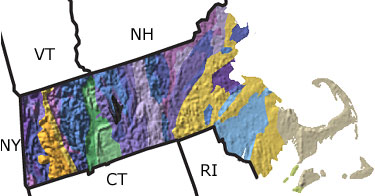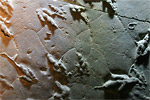Massachusetts, US
|
|
|||||||||||||||||||||||||||||||||||||||||||||||||||||||||||||
Paleontology and geology
The Precambrian: Rocks of Precambrian age are found in a broad band extending over much of western, eastern, and southeastern Massachusetts. These rocks are metamorphic and igneous and contain no fossils.
The Paleozoic: There were two main mountain-building events in the Paleozoic — the Taconic and Acadian Orogenies. As a result of these orogenies, most Paleozoic rocks in Massachusetts are igneous or metamorphic and contain few fossils. However, the presence of some fossils of trilobites, brachiopods, and other marine organisms from the Early Paleozoic indicate that a sea covered Massachusetts during at least part of this time. Rocks formed during the Carboniferous have been highly folded, fractured, somewhat metamorphosed, and also lack fossils. There are no Permian rocks known from Massachusetts, as this was a time of further uplift and erosion in the state.
The Mesozoic: Mesozoic sedimentary rocks in Massachusetts were originally sediments deposited in alluvial fans, braided streams, and lakes that filled rift valleys. These deposits contain trace fossils of invertebrates, dinosaur tracks, and fossil plants. Interbedded within these sediments are volcanic rocks that formed as the supercontinent of Pangea began to pull apart. Cretaceous rocks occur only on the Elizabeth Islands off the southwestern end of Cape Cod and the nearby island of Martha’s Vineyard. They consist of fine sand and clay layers deposited on an ancient coastal plain and shallow seafloor. Fossils of flowers and pine needles have been recovered from these sediments.
The Cenozoic: There are no surface Tertiary rocks in Massachusetts; however, the presence of Pleistocene sediments record the advance and retreat of great ice sheets over Massachusetts. Mastodon bones and fossilized molluscs have been recovered from these sediments on Cape Cod.
Links to more on Massachusetts paleontology
Research and Collections | Resources
Research and CollectionsResourcesResearchers (showing 1 of 1 listings)
Museum Collections: Information on the department collections of the Museum of Comparative Zoology, including geology and paleontology.
Curriculum and Classroom Resources (showing 1 of 1 listings)
Teacher-Friendly Guides to Geology: Provides teachers with an intuitive and jargon-free review of the geology of different regions of the United States.
Field Guides (showing 1 of 1 listings)
Dinosaur Footprints and Trackways From the Northeastern U.S.: This webpage details footprints from the Triassic and Jurassic periods of the northeastern United States. Information includes photographs of footprints, along with information on stratigraphic horizon and correlation, age, and taxonomy.

